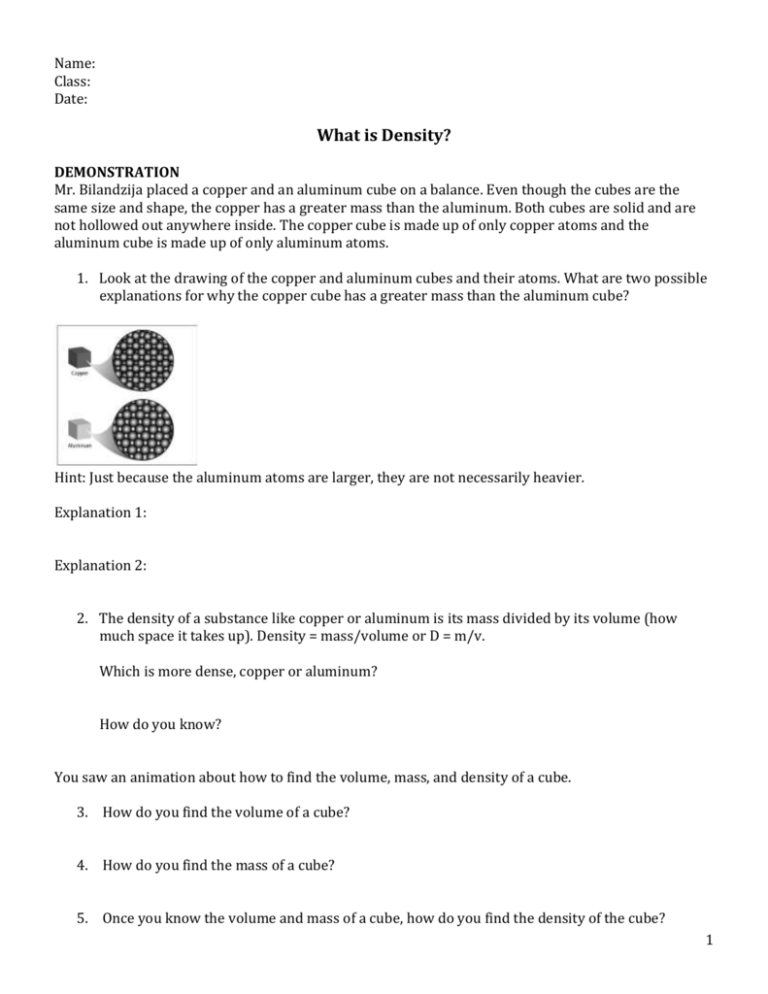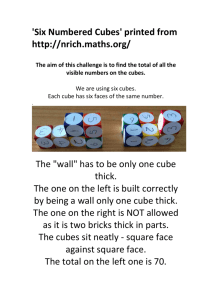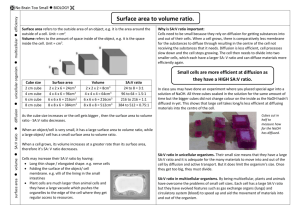What is Density? Lab - Odyssey Charter School
advertisement

Name: Class: Date: What is Density? DEMONSTRATION Mr. Bilandzija placed a copper and an aluminum cube on a balance. Even though the cubes are the same size and shape, the copper has a greater mass than the aluminum. Both cubes are solid and are not hollowed out anywhere inside. The copper cube is made up of only copper atoms and the aluminum cube is made up of only aluminum atoms. 1. Look at the drawing of the copper and aluminum cubes and their atoms. What are two possible explanations for why the copper cube has a greater mass than the aluminum cube? Hint: Just because the aluminum atoms are larger, they are not necessarily heavier. Explanation 1: Explanation 2: 2. The density of a substance like copper or aluminum is its mass divided by its volume (how much space it takes up). Density = mass/volume or D = m/v. Which is more dense, copper or aluminum? How do you know? You saw an animation about how to find the volume, mass, and density of a cube. 3. How do you find the volume of a cube? 4. How do you find the mass of a cube? 5. Once you know the volume and mass of a cube, how do you find the density of the cube? 1 6. Calculate the density of a cube using the following information: Each side is 4 cm long. The mass of the cube is 128 g. ACTIVITY Question to investigate: Can you use density to identify eight cubes made of different materials? Task: Your group will work with eight cubes each with the same volume, but made of a different material. Each group will rotate through three stations in order to weigh each sample. Carefully measure the mass of each cube and calculate the density at each station. When you leave the station, make sure you put the cubes back in the right spot. When you are done with all stations, use density to correctly identify each of the 8 cubes. Procedure 1. The volume of each cube is given in the chart. It is 15.6 cm3. 2. Find the mass in grams of each cube using a balance. Record this mass in the chart. 3. Rotate through each station until you have measured the mass of all eight cubes 4. Calculate the density using the formula D = m/v and record it in the chart. 5. Compare the value you found for density with the given value in the chart below to identify which cube is made out of which material. Write the name of the material in your chart for cubes A–H. 2 EXPLAIN IT WITH ATOMS & MOLECULES 7. The size, mass, and arrangement of atoms affect the density of a substance. If a substance has a high density, what can you guess about the size, mass, and arrangement of the atoms that make up the substance? If a substance has a low density, what can you guess about the size, mass, and arrangement of the atoms that make up the substance? TAKE IT FURTHER In this activity, you investigated cubes made out of different substances. The cubes had the same volume, but different masses. When you calculated the density of each cube, you found that this was different, too. 8. Now imagine two blocks (Sample A and Sample B) made of different substances that both have the same mass, but different volumes. a. What is the density of Sample A? b. What is the density of Sample B? c. Give two possible explanations for why one sample is more dense than the other. Hint: The size, mass, and arrangement of molecules affect the density of a substance. 3








